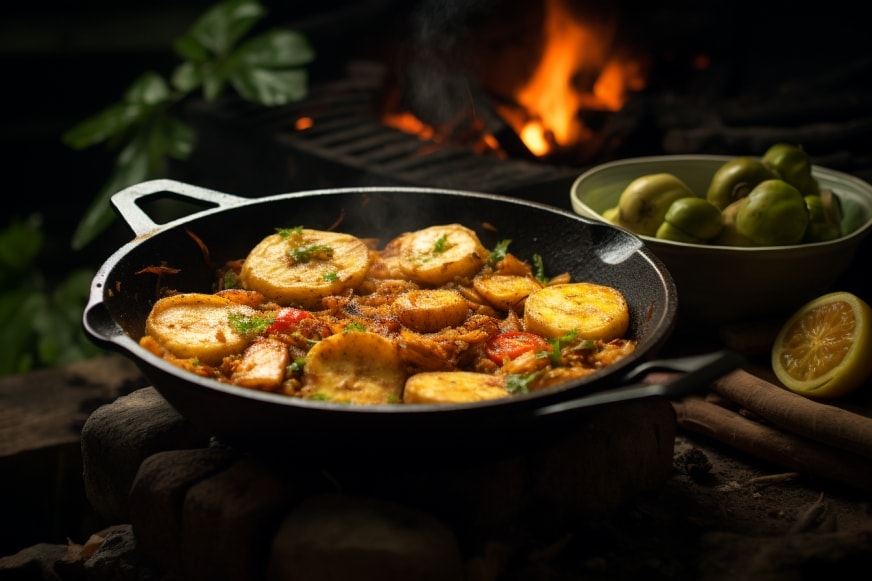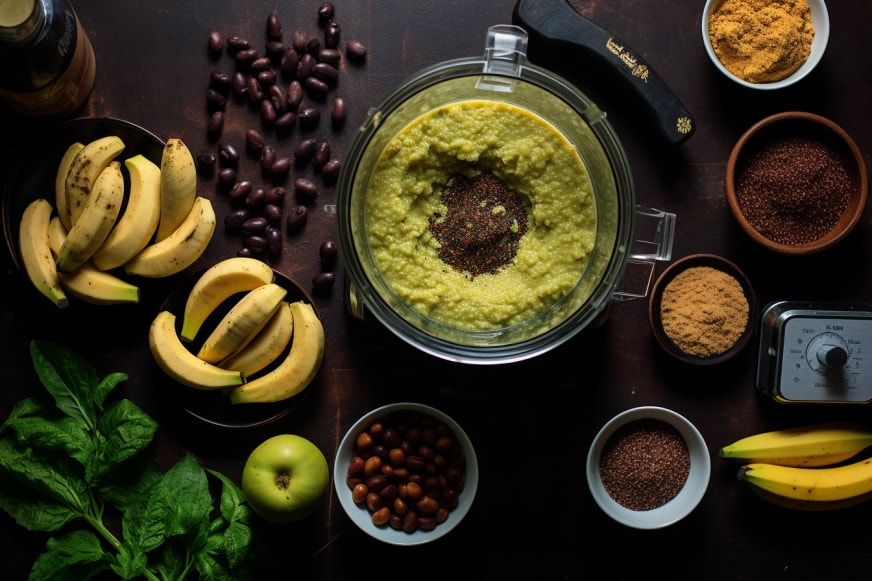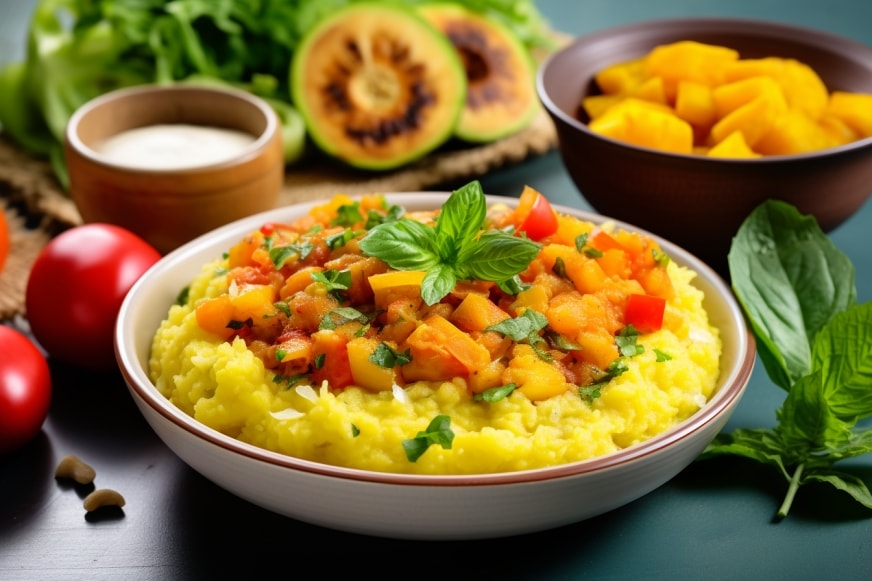Table of Contents
ToggleDominican Delicacy: Vegan Mangu (Mashed Plantains) for Babies
Here’s the thing about parenting: we spend so much time worrying about the “right” foods, the “perfect” nutrition, the “best” choices for our babies. But what if the magic isn’t in perfection? What if it’s in the simple act of sharing something meaningful?
I discovered this truth through Mangu—a humble Dominican dish that changed everything I thought I knew about baby food. This isn’t just mashed plantains. This is a story that begins with the Taino people, travels through generations of Dominican families, and lands right here in your kitchen, ready to become part of your baby’s journey.
Picture this: Your baby takes their first bite of something creamy, naturally sweet, and comforting. Their eyes light up—not just because it tastes good, but because you’re sharing something real. Something with soul. That’s what happens when food carries more than just nutrients. It carries history, love, and connection.

Why This Matters More Than You Think
Let me share something with you. When the Taino people first cultivated plantains on this beautiful Caribbean island, they weren’t just growing food. They were creating something that would survive colonization, cultural shifts, and centuries of change. They were planting seeds of resilience.
Fast forward to today, and here we are—still celebrating this incredible fruit that has nourished families through everything life could throw at them. When you make Mangu for your baby, you’re not just preparing a meal. You’re participating in something much bigger.
Think about it: How often do we get the chance to give our children something that connects them to the world beyond our four walls? Something that whispers stories of different cultures, different ways of life, different kinds of love?

What Your Baby Actually Gets From This
Let’s talk about what really matters—what this does for your little one. Because yes, it tastes amazing, but the benefits go so much deeper.
Ripe plantains are like nature’s perfect baby food. They’re loaded with fiber that keeps your baby’s digestion happy and regular. They’re packed with vitamin A for healthy vision and a strong immune system. They contain vitamin B6, which supports brain development at exactly the stage when your baby needs it most.
But here’s where it gets interesting—when you add avocado to the mix, you’re introducing healthy fats that literally help build your baby’s brain. We’re talking about the kind of nutrition that supports not just today’s growth, but tomorrow’s potential.
The natural sugars in plantains provide gentle, sustained energy. No sugar crash, no artificial additives—just pure, clean fuel for your active little explorer.

The Truth About Getting Started
Here’s what no one tells you about introducing new foods to your baby: it’s not about having the perfect plan. It’s about starting before you feel completely ready and learning as you go.
Maybe you’re worried about allergies. Maybe you’re not sure about textures. Maybe you think you need to be some kind of baby food expert to pull this off. I get it. But here’s the beautiful truth—your baby doesn’t need perfection. They need you to try.
Start small. Watch how they respond. Trust your instincts. Every baby is different, and yours will let you know what works. The magic happens not in the first bite, but in all the little moments that follow—the messy faces, the curious looks, the gradual acceptance of something new and wonderful.
| What to Remember | Why It Matters |
|---|---|
| Start Small and Observe | When introducing Mangu to your baby, begin with small portions. This allows you to gauge their response and detect any potential allergic reactions or sensitivities. Keep a watchful eye as you embark on this flavor-filled journey together. |
| Avocado: Creaminess and Nutrient Boost | Incorporating avocado into your baby’s Mangu not only adds creaminess but also introduces a dose of healthy fats. These fats are crucial for brain development and overall growth, making this dish not just delicious but incredibly nutritious. |
| Watch for Allergenicity | As with any new food, keep an eye out for potential allergenic reactions. Start by offering Mangu during the day, preferably in the morning. This ensures that you have ample time to monitor your baby and address any concerns that may arise. |
| Consult Your Pediatrician | Before introducing Mangu or any new food to your baby’s diet, it’s essential to consult your pediatrician. They can provide personalized guidance based on your baby’s unique dietary needs and health history. |
| Embrace Gradual Introduction | Mangu can be a wonderful addition to your baby’s menu, but remember that variety is key. Gradually introduce different foods and textures to ensure a well-rounded diet. As your baby explores the world of flavors, they’re also expanding their palate and nutritional intake. |

Baby-Friendly Vegan Mangu Recipe
Ready to create something special? This recipe is more than instructions—it’s your gateway to sharing culture, nutrition, and love with your little one.
What You’ll Need:
- Ripe plantains – 2
- Avocado – 1
- Coconut oil – 1 tablespoon
- A pinch of salt (optional, for babies 12+ months only)
Age-Based Preparation Guide:
6-8 Months (First Foods)
Consistency: Thin enough to drip off spoon
Serving size: 1-2 teaspoons to start
- Use a food processor or immersion blender for completely smooth texture
- Add extra coconut oil, breast milk, or formula to thin consistency
- Blend until no lumps remain – should be silky smooth
- Skip salt completely at this age
- Introduce avocado separately first, then blend together if no allergic reactions
8-10 Months (Exploring Textures)
Consistency: Should hold on spoon but still be creamy
Serving size: 2-4 tablespoons
- Mash by hand thoroughly or use blender on pulse setting for slight texture
- Perfect consistency as written in main recipe
- Can start offering small finger-food pieces alongside puree
- Still no salt needed
- Great time to let baby self-feed with supervision
10-12 Months (Chunky Adventures)
Consistency: Thick enough to pick up with fingers
Serving size: 1/4 to 1/2 cup
- Hand mash with less pressure, leaving pea-sized soft chunks
- Avoid blending at this stage – babies need texture practice
- Perfect for practicing pincer grasp
- Can serve as finger food formed into small patties
- Still avoid salt until 12 months
- Great mixed with other foods baby has tried
12+ Months (Toddler Style)
Consistency: Can be chunky or smooth based on preference
Serving size: 1/2 cup or more
- Can add tiny pinch of salt if desired (still keep minimal)
- Try adding mild spices like cinnamon or a touch of vanilla
- Perfect for self-feeding with utensils
- Can be served as side dish with other family foods
- Great base for adding other fruits or vegetables
Let’s Make Magic:
Start by peeling and chopping the ripe plantains into evenly sized pieces. This ensures uniform cooking and a consistent texture for your Mangu.
Choose your preferred method – steaming or boiling – to cook the plantains until they are tender. Steaming helps retain their vibrant color and natural sweetness, while boiling adds a slightly different dimension to the flavors.
Once your plantains are cooked to perfection, you have two options:
- Hand mashing: Transfer to a bowl and use a fork or potato masher. Perfect for maintaining some texture and control.
- Blending: Use a food processor, immersion blender, or regular blender for ultra-smooth consistency. Add a splash of cooking water or breast milk/formula if needed.
Adjust texture based on your baby’s age (see age guide above). Blending works especially well for younger babies (6-8 months) who need completely smooth purees.
Halve the avocado, remove the pit, and scoop out the creamy flesh. Mash the avocado separately and then incorporate it into the mashed plantains. This not only enhances the texture but also introduces healthy fats that are essential for your baby’s growth and development.
Add a tablespoon of coconut oil to the mixture, gently folding it in. The coconut oil not only adds a hint of tropical flavor but also enriches the dish with its health benefits.
For babies under 12 months, skip any salt. For toddlers 12+ months, you can add a tiny pinch of salt if desired, but remember that babies’ sodium intake should be very limited.
Your baby-friendly Vegan Mangu is now ready to be savored! Serve it in small, manageable portions appropriate for your baby’s age. As you watch them explore the flavors, textures, and tastes of this dish, you’re not just sharing a meal; you’re sharing a piece of heritage and a love for wholesome, authentic cuisine.
Safety & Serving Tips:
- Always supervise your baby while eating, especially with new textures
- Test temperature before serving – it should be warm, not hot
- Start small – offer just a few spoonfuls the first time
- Watch for reactions – introduce avocado separately first if baby hasn’t tried it
- Store safely – refrigerate leftovers for up to 3 days, or freeze in ice cube trays for up to 3 months
- Trust your baby – they’ll let you know if they’re ready for more texture or flavor
What Happens Next
Here’s what I want you to remember as you embark on this journey: this isn’t just about one recipe or one meal. This is about opening doors. When your baby tastes Mangu for the first time, you’re introducing them to the idea that food can be an adventure, that different cultures have incredible gifts to share, and that some of the most meaningful experiences come from the simplest moments.
As your little one grows, they’ll carry these flavors with them. They’ll remember the day you first shared something special from the Dominican Republic. They’ll understand that the world is full of beautiful, delicious discoveries waiting to be made.
So go ahead—make that Mangu. Watch your baby’s face light up. Take pictures of the messy fingers and the curious expressions. Because these moments, these simple acts of sharing and exploring together, this is what creates a lifetime of openness, curiosity, and appreciation for the incredible diversity our world has to offer.
Your kitchen isn’t just where you prepare food—it’s where you create memories, share cultures, and nurture a love for discovery that will last a lifetime. And it all starts with something as simple as mashed plantains, made with love.
Want to take your knowledge to the next level? Check out these must-read articles:
- Antiguan Adventure: Vegan Caribbean Conch Chowder
- Caribbean Curry Cauliflower: Cauliflower and Chickpea Puree
Organize your baby’s wardrobe with our baby clothes closet organizer products! Our organizers are designed specifically for baby clothes. Get your baby’s clothes neat and tidy with our selection of organizers – shop now!
- Picky Eating Prevention: Foundations in the First Year - October 17, 2025
- The Great Nursing Strike: Causes and Solutions - October 7, 2025
- DIY Baby Food: Equipment-Free Approaches - October 1, 2025



